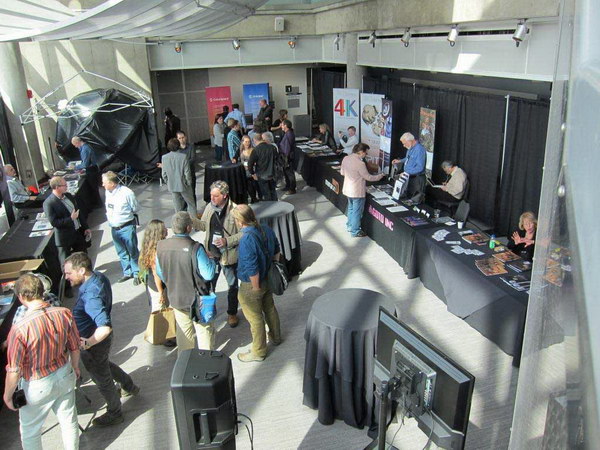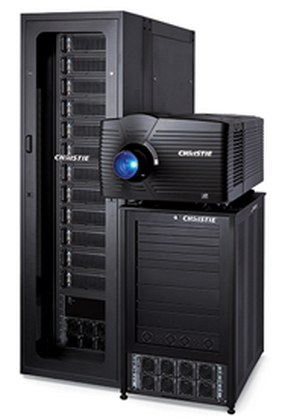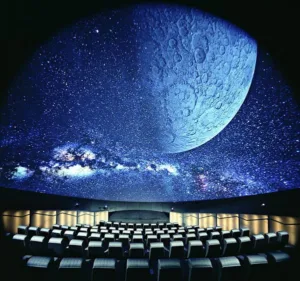IMERSA (Immersive Media Entertainment, Research, Science & Arts) is having it’s 8th annual summit February 22 – 26 in Denver at the Denver Museum of Nature & Science (DMNS). There will be lots of news about dome displays.
 Pro Show at IMERSA 2016 (Photo IMERSA)
Pro Show at IMERSA 2016 (Photo IMERSA)
According to the organization’s website, “IMERSA Inc. is a non-profit business league whose roots are deeply embedded in the rise of the digital planetarium (fulldome). Incorporated in 2008 our founding sponsors initiated ongoing research and development programs in search of standards and guidelines for fulldome production and technologies.” The organization is not limited to planetariums, “IMERSA embraces many forms of digital immersion, including Planetariums, Giant Screen Cinema, VR headsets and spherical environments.”
While there will be speakers and a technical exhibition, the main focus of the IMERSA Summit is showing full-dome immersive shows on the Gates Planetarium’s projectors. There have been 10 full length shows chosen for the Summit. Most of these are astronomy-related, such as Aurora: Lights of Wonder, produced by Metaspace in Korea. Full-dome shows are not always astronomical and The Secret World of Moths, jointly produced by the Nordic Fulldome Production and The Finnish Science Centre, was also chosen. In addition to these ten full length shows, 20 short shows have been chosen for the Summit, including portions of four that are still in production. Some of these sound like they would make good VR content for headsets, such as Sinkholes in Yucatan: Doors to Another World, produced by Planetarios Digitales in Mexico.
Planetariums have been one of the last hold-outs in the film to digital revolution in projection technology. The reason is simple – digital projectors until recently were simply not capable of putting sufficient lumens and sufficient pixels on the larger full-dome screens. This has changed and planetariums world-wide are replacing their 70mm film projectors digital projectors.
Image on the Gates Planetarium full-dome screen produced by eight Barco F35 projectors
For example, the Gates Planetarium, to be used by the IMERSA summit, upgraded their projectors in September 2016 with digital projectors. Evens and Sutherland (E&S) was the contractor and they used their 8-channel Digistar 6 system as the video server. It was connected to eight Barco F35 2560 x 1600 resolution projectors. The Barco F35 is a single chip DLP projector that uses two 300W UHP VIDI lamps to put up to 7500 lumens on the screen, depending on the color wheel and the lens. Each lamp has a full-power lifetime of 2,000 hours. This produces a total of up to 60,000 lumens, before edge-blending. After edge-blending with the E&S proprietary software, the system produces well over 20 million unique pixels on the full-dome screen. For comparison, a UHD-1 (4K) TV has about 8.3 million pixels and a UHD-2 (8K) TV has about 33.2 Million pixels.
 Layout of the tilted full-dome screen and 134 seats in the Gates Planetarium
Layout of the tilted full-dome screen and 134 seats in the Gates Planetarium
According to Dan Neafus, Planetarium Operations Manager at the Gates Planetarium, this is the second upgrade to the projection system. The original upgrade was in 2003 when the previous CRT systems were replaced by 11 Barco Sim 6 projectors. After the 2003 upgrade, he said the Gates was the first “4K, real-time, digital Planetarium.” He says the planetarium does not have an optical star field projector (e.g. Zeiss) and the stars are generated by the Barco F35 projectors. When I asked him if “Gates” in the Gates Planetarium referred to Bill Gates, he said no. The planetarium is named after Charles Gates Sr., who died in 1961. His son, Charles Gates Jr. served on the board of the DMNS until his death in 2005 and subsidized the 2003 upgrade. Neafus added that the IMAX theater at the DMNS was upgraded from film to digital in 2010 and there is no film currently in use at the DMNS. When asked if the DMNS used any other immersive environments, he said, “Not yet, we are exploring some prototype installations of 4D experiences using VR.”
In another example of digital planetariums, Christie partnered with D3D Cinema in 2015 to develop full-dome laser projection systems based on Christie RGB laser projectors. Part of the project involved scanning existing 70mm full-dome film content at 11K resolution to convert it to digital content. 11K resolution corresponds roughly to 63 million pixels. The Christie/D3D systems with dual 4K laser projectors are said to have up to 150,000 lumens.
“Dome theaters have waited a long time for digital projection technology to evolve to a capable solution that can rival or exceed the quality of 70 mm,” said Don Kempf president and founder of D3D. “Just as lasers usher in a new era for dome cinema exhibition, new digital capture technology ushers in a new era for the production of dome-specific content to support the incredible dynamic range of the lasers.”
The first Christie/D3D installation was announced in August, 2016 for the Cleveland Clinic Dome Theater at Great Lakes Science Center (GLSC) This installation provides about 6K resolution on their full-dome screen. It was a $1.8 million project and shut the theater down for about 1½ months in late fall of 2016. The upgrade included an audio upgrade and interior finishes but no major construction.
 The Christie CP42LH RGB laser projector produces 5,000 – 60,000 lumens with 1-12 Laser Modules. Dual-projector systems are needed to break the 100,000 lumen barrier and illuminate the largest dome theaters.
The Christie CP42LH RGB laser projector produces 5,000 – 60,000 lumens with 1-12 Laser Modules. Dual-projector systems are needed to break the 100,000 lumen barrier and illuminate the largest dome theaters.
Since then, D3D has announced three other installations of the Christie/D3D laser system, including two announcements just this month. One will go to the Chicago Museum of Science and Industry and the other will go to the Fernbank Museum of Natural History (FMNH) in Atlanta, Georgia. The FMNH installation is expected to be complete by February, 2017. In the Rankin M. Smith, Sr. Giant Screen Theater at the FMNH, D3D will replace the existing projection system with dual Christie Digital 4K 3D laser-illuminated projectors, a premium QSC 5.1 audio system and a new screen from MDI. The state-of-the-art laser projectors will illuminate the theater’s giant screen with an expanded color gamut and 3D images well beyond the capabilities of the former IMAX 15/70 2D film-based projection system. At the same time, D3D is upgrading a second auditorium at the FMNH with a 2K xenon-illuminated projector.
The fourth Christie/D3D installation was announced last October for the Carnegie Science Center (CSC) in Pittsburgh. Installation is expected to take place in the fall of 2017. One interesting thing about this installation is it will use a Dolby Atmos multichannel surround sound system – said to be a first for institutional giant screen theaters.
The future for RGB laser projection is BRIGHT! (And loud, too!) – Matthew Brennesholtz

